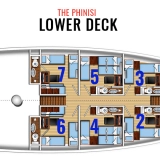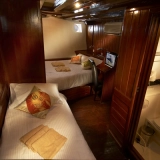





























DIVING MYANMAR (BURMA) 10 NIGHTS (RANONG - RANONG)
Cruise name
Company
June Hong Chian Lee
Class
Midrange
Capacity
7 cabin
Type
Sharing
Destination
Thailand - Thailand
DIVING MYANMAR (BURMA) 10 NIGHTS (RANONG - RANONG)
- Cruise name : June Hong Chian Lee
- Company : June Hong Chian Lee
- Class : Midrange
- Capacity : 7 cabin
- Type : Sharing
- Destination : Thailand - Thailand
High Rock - North and South Twin - Captain’s Rock - Black Rock - Tower Rock - Torres Island
Itineraries
Schedule
Your Cruise Director will schedule up to 4 dives per day; 3 day dives and either a sunset or a night dive. The diving day has a typical schedule as follows:
Your Cruise Director will schedule up to 4 dives per day; 3 day dives and either a sunset or a night dive. The diving day has a typical schedule as follows:
- Light Breakfast followed by a briefing & Dive 1
- Full Breakfast, relaxation followed by briefing & Dive 2
- Lunch, relaxation followed by briefing & Dive 3
- Snack, relaxation, followed by briefing & Dive 4
Generally, we schedule 2 dives on your final dive day in order to allow enough time for off-gassing. To remain on the safe side, we kindly request our guests to check their own flight times and ensure that they leave a minimum of 24 hours between their final dive and their return flight. Guests are welcome to suggest preferred dive sites to the Cruise Director. He/she will be happy to accommodate guests’ wishes, providing it is possible and the schedule allows for it.
Dive sites we visit include but are not limited to:
High Rock
This is a tiny islet with a lonely tree growing on the top. Underwater, you will find a steep rocky reef with lots of tube and fan corals. Lots of critters hang around the cracks including nudibranchs, pipe fish and seahorses. Visibility and currents can sometimes be challenging but it is a rewarding site.
North and South Twin & Captain’s Rock
Strong currents bring with them teams of schooling fish and with superb visibility the atmosphere on the reef at North Twin is breathtaking.
Hard corals have seen damage from the rise in water temperature but soft corals adorn the reef and bring vibrancy.
In South Twin we can expect to see an abundance of moray eels, harlequin sweetlips and cuttlefish.
Captain’s Rock, otherwise known as Bowie Rock, is a sloping reef with huge soft coral covered boulders. Sweetlips, barracuda, a variety of angel fish and many smaller creatures including devil scorpion fish, pipe fish, shrimps and flabellina nudibranchs can be found all over the reef. Mantas may also been seen here.
Black Rock
Black Rock stands alone in the Andaman Sea 100 miles northwest of the ThaiBurmese border town of Kawthaung. The rock acts as a natural magnet for fish and other marine life. An excellent multi-level site, you can start your dive anywhere around the perimeter, depending on currents.
Underwater terrain on the south side consists of vertical wall down to roughly 27m, where it becomes a more gradual slope. Just off the south-west corner is a particularly interesting area, where a detached rock formation rises from very deep water to about 24m. These rocks are covered with small, vibrant soft corals, and often attract schooling snappers and rainbow runners. Back at the main islet, deeper sections are decorated with orange gorgonian fans, along with fields of corallimorpharians (they look like stony corals) on the sloping west and north sides. At the eastern tip, watch for vast numbers of magnificent anemones, especially at dawn and dusk when they show off their colourful bases.
A wide range of invertebrate life can be found at Black Rock, including smashing and spearing mantis shrimp, spiny lobsters, hermit crabs, sea stars, cowrie shells, harlequin shrimp, octopus and cuttlefish.
During safety stops, move slowly along the eastern and western ends of the south wall to find brilliantly coloured elegant hermit crabs and a variety of nudibranchs, as well as golden wentletrap snails that feed on the orange cup coral. Fish life is also abundant and varied, with a chance to see almost anything from scorpion fish and giant morays to marbled sting rays. Mantas and even whale sharks are also sometimes visitors of this site.
Shark Cave aka Three Islets
All around this site, marine life is extremely rich and diverse. There are three different rocky islets with vertical walls as well as sloping reef. Many areas are populated with fields of anemones, which are home to five different species of anemone fish. Elsewhere, large tubastrea coral trees sprout from the rocky terrain, accompanied by crinoids, gorgonian fans and pastel green rope sponge. Tiger tail sea horses are often encountered on the deep edges of the slope, as are many varieties of morays - often several species in the same hole.
Cuttlefish may be found at nearly any depth, sometimes courting and mating. Ornate ghost pipe fish, cowrie shells, octopus, reef squid, jaw fish, porcelain crabs, long nose pipe fish, and mantis shrimps are often seen at this site. Scorpion fish are very abundant, so be careful where you place your hands! Between the three pinnacles and surrounding bottom, Shark Cave easily lends itself to several dives to enjoy the diversity of the reef and to marvel in the chasm of the Shark Cave! Nurse sharks can be found lurking inside the cavern along with marble rays, ghost pipefish and plenty of other fascinating creatures, including blue ribbon eels.
Little Torres Island
Due to its remote location this is a good dive site for appreciating the a kaleidoscope of colours from the hundreds of corals types in abundance such as table corals, mosaic corals and red whip corals to name a few. The corals are surrounded by healthy reef life and huge submerged boulders, as well as the occasional sting ray and the rare leopard sharks on the sea bed nearby. There is also a good chance of seeing black banded sea snakes here. Chances of spotting sharks, whale sharks and mantas. The "Sea Fan Forest" is an enchanting patch where lionfish, moorish idols and several cowries are present.
Tower Rock
As its name suggests, this is a magical dive site with towering walls descending into the depths. Below the water you will find a lunar site of boulders, made up from the taller reaches of Tower Rock in years past.
The walls are laced with whip corals and sea fans, oysters and clams. White banded cleaner shrimp and ornate spiny lobster hide amongst the crags, whilst blue faced angelfish and yellow striped fusiliers dance their way up the walls.
Larger visitors include manta rays and mobula rays, as well as blacktip and whitetip reef sharks. Moray eels, bearded scorpionfish, schools of snappers and fusiliers are among the usual suspects.
Fan Forest & Western Rocky
As the name Fan Forest Pinnacle suggests, it is a submerged pinnacle famous for the amount of gorgonian seafans. The biggest gorgonians are in deeper waters around 20 m and below.
They are very healthy and support a large variety of marine life including feather stars, cowries, hawk fish and shrimps. Schooling fish include snapper, trevally, rainbow runners and fusiliers. Moray eels and scorpion fish are also numerous.
A short trip south of Sea Fan, Western Rocky is the scene of dramatic underwater terrain on this excellent dive site, which consists of a main islet plus several detached pinnacles. Among the more striking features of the main islet is a huge underwater archway where schooling snapper often hang out. The soft limestone island is riddled with holes and crevices, providing hiding places for hinge-beak, saron and harlequin shrimps, thorny oysters, cowrie shells, nudibranchs, spiny lobsters and moray eels.
Large gorgonian fans and lush soft corals populate many of the deeper areas, while shallow portions of the south side wall are covered with orange cup corals and colourful encrusting sponges. Fish life can include almost anything from ornate ghost pipefish to frog fish to schooling batfish. Western Rocky pinnacle is shaped like a cheese wedge covered by both hard and soft corals, lots of trevally and tuna, and if you are lucky, the elusive bow mouth guitarfish.
Dive sites we visit include but are not limited to:
High Rock
This is a tiny islet with a lonely tree growing on the top. Underwater, you will find a steep rocky reef with lots of tube and fan corals. Lots of critters hang around the cracks including nudibranchs, pipe fish and seahorses. Visibility and currents can sometimes be challenging but it is a rewarding site.
North and South Twin & Captain’s Rock
Strong currents bring with them teams of schooling fish and with superb visibility the atmosphere on the reef at North Twin is breathtaking.
Hard corals have seen damage from the rise in water temperature but soft corals adorn the reef and bring vibrancy.
In South Twin we can expect to see an abundance of moray eels, harlequin sweetlips and cuttlefish.
Captain’s Rock, otherwise known as Bowie Rock, is a sloping reef with huge soft coral covered boulders. Sweetlips, barracuda, a variety of angel fish and many smaller creatures including devil scorpion fish, pipe fish, shrimps and flabellina nudibranchs can be found all over the reef. Mantas may also been seen here.
Black Rock
Black Rock stands alone in the Andaman Sea 100 miles northwest of the ThaiBurmese border town of Kawthaung. The rock acts as a natural magnet for fish and other marine life. An excellent multi-level site, you can start your dive anywhere around the perimeter, depending on currents.
Underwater terrain on the south side consists of vertical wall down to roughly 27m, where it becomes a more gradual slope. Just off the south-west corner is a particularly interesting area, where a detached rock formation rises from very deep water to about 24m. These rocks are covered with small, vibrant soft corals, and often attract schooling snappers and rainbow runners. Back at the main islet, deeper sections are decorated with orange gorgonian fans, along with fields of corallimorpharians (they look like stony corals) on the sloping west and north sides. At the eastern tip, watch for vast numbers of magnificent anemones, especially at dawn and dusk when they show off their colourful bases.
A wide range of invertebrate life can be found at Black Rock, including smashing and spearing mantis shrimp, spiny lobsters, hermit crabs, sea stars, cowrie shells, harlequin shrimp, octopus and cuttlefish.
During safety stops, move slowly along the eastern and western ends of the south wall to find brilliantly coloured elegant hermit crabs and a variety of nudibranchs, as well as golden wentletrap snails that feed on the orange cup coral. Fish life is also abundant and varied, with a chance to see almost anything from scorpion fish and giant morays to marbled sting rays. Mantas and even whale sharks are also sometimes visitors of this site.
Shark Cave aka Three Islets
All around this site, marine life is extremely rich and diverse. There are three different rocky islets with vertical walls as well as sloping reef. Many areas are populated with fields of anemones, which are home to five different species of anemone fish. Elsewhere, large tubastrea coral trees sprout from the rocky terrain, accompanied by crinoids, gorgonian fans and pastel green rope sponge. Tiger tail sea horses are often encountered on the deep edges of the slope, as are many varieties of morays - often several species in the same hole.
Cuttlefish may be found at nearly any depth, sometimes courting and mating. Ornate ghost pipe fish, cowrie shells, octopus, reef squid, jaw fish, porcelain crabs, long nose pipe fish, and mantis shrimps are often seen at this site. Scorpion fish are very abundant, so be careful where you place your hands! Between the three pinnacles and surrounding bottom, Shark Cave easily lends itself to several dives to enjoy the diversity of the reef and to marvel in the chasm of the Shark Cave! Nurse sharks can be found lurking inside the cavern along with marble rays, ghost pipefish and plenty of other fascinating creatures, including blue ribbon eels.
Little Torres Island
Due to its remote location this is a good dive site for appreciating the a kaleidoscope of colours from the hundreds of corals types in abundance such as table corals, mosaic corals and red whip corals to name a few. The corals are surrounded by healthy reef life and huge submerged boulders, as well as the occasional sting ray and the rare leopard sharks on the sea bed nearby. There is also a good chance of seeing black banded sea snakes here. Chances of spotting sharks, whale sharks and mantas. The "Sea Fan Forest" is an enchanting patch where lionfish, moorish idols and several cowries are present.
Tower Rock
As its name suggests, this is a magical dive site with towering walls descending into the depths. Below the water you will find a lunar site of boulders, made up from the taller reaches of Tower Rock in years past.
The walls are laced with whip corals and sea fans, oysters and clams. White banded cleaner shrimp and ornate spiny lobster hide amongst the crags, whilst blue faced angelfish and yellow striped fusiliers dance their way up the walls.
Larger visitors include manta rays and mobula rays, as well as blacktip and whitetip reef sharks. Moray eels, bearded scorpionfish, schools of snappers and fusiliers are among the usual suspects.
Fan Forest & Western Rocky
As the name Fan Forest Pinnacle suggests, it is a submerged pinnacle famous for the amount of gorgonian seafans. The biggest gorgonians are in deeper waters around 20 m and below.
They are very healthy and support a large variety of marine life including feather stars, cowries, hawk fish and shrimps. Schooling fish include snapper, trevally, rainbow runners and fusiliers. Moray eels and scorpion fish are also numerous.
A short trip south of Sea Fan, Western Rocky is the scene of dramatic underwater terrain on this excellent dive site, which consists of a main islet plus several detached pinnacles. Among the more striking features of the main islet is a huge underwater archway where schooling snapper often hang out. The soft limestone island is riddled with holes and crevices, providing hiding places for hinge-beak, saron and harlequin shrimps, thorny oysters, cowrie shells, nudibranchs, spiny lobsters and moray eels.
Large gorgonian fans and lush soft corals populate many of the deeper areas, while shallow portions of the south side wall are covered with orange cup corals and colourful encrusting sponges. Fish life can include almost anything from ornate ghost pipefish to frog fish to schooling batfish. Western Rocky pinnacle is shaped like a cheese wedge covered by both hard and soft corals, lots of trevally and tuna, and if you are lucky, the elusive bow mouth guitarfish.
Check rate
Important Notes
Price includes
- Full board accommodations,
- Breakfast, lunch, dinner,
- Tea, coffee, snacks
- Fruit between dives.
Price excludes
- Gratuities
- Laundry
- Shop purchases
- Other personal expenses
- National Marine Parks Fee
- Diving insurance
Remark:
- Cruise itinerary and schedule are subject to change due to weather and operating conditions. Unused services are not subject to a refund.
- Similan Island and Surin National Park fees are not included and can change without notice. Currently the National Parks charge entry fees for the Similan and the Surin National Parks per day as a diving fee. This National Park fees are not included in the trip price and will be charged separately in cash and Thai Baht on the boat. Weather conditions, political events and special marine life sightings may influence the daily schedule and number of dives.
- Meals on board are fusion: Thai & international. Guests should advise of any special food preferences, allergies or dietary requirements at least three days prior to the cruise date.
Other itineraries
1
DIVING THE SIMILAN ISLANDS 6 NIGHTS (PHUKET - KHAO LAK)
Upstream
Destination : Similan Islands, Koh Bon, Koh Tachai, Richelieu Rock, Surin Islands
2
DIVING SOUTHERN THAILAND 4 NIGHTS (PHUKET - PHUKET)
Destination : Koh Phi Phi, King Cruiser, Shark Point, Koh Doc Mai, Koh Haa, Hin Daeng & Hin Muang
3
DIVING THE BEST OF THAILAND 10 NIGHTS (KHAO LAK - KHAO LAK)
Destination : Similan Islands, Koh Bon, Koh Tachai, Richelieu Rock, Surin Islands, Koh Phi Phi, King Cruiser, Shark Point, Koh Haa, Hin Daeng & Hin Muang
4
DIVING MYANMAR (BURMA) 7 NIGHTS (RANONG - RANONG)
Destination : High Rock, North and South Twin, Captain’s Rock, Black Rock, Tower Rock, Torres Island